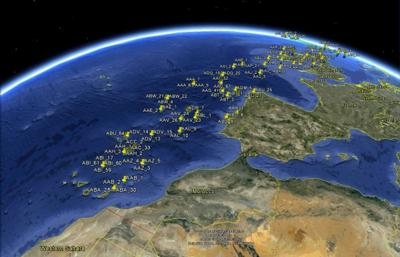Fri, Jun 14, 2013
'Guest Payload' Aboard The Satellite Includes ADS-B Experiment
ESA’s Proba-V has become the first satellite to pick up aircraft tracking signals, allowing aircraft across the globe to be followed in flight from space. “We have succeeded in proving that these relatively low-powered air traffic control signals can indeed be detected from space as they are, without any need for upgraded aircraft equipment,” explained Toni Delovski of the DLR German Aerospace Center, overseeing the experiment. "Now we want to go on and check how many aircraft we can actually observe in practice, and which types – different sized aircraft being assigned systems with differing signal strengths. This research opens the way to operational space-based aircraft monitoring in future.”

Launched on May 7, Proba-V’s main task is to map vegetation growth, covering the whole world every two days. But the minisatellite – smaller than a cubic meter – also doubles as a miniature research lab, testing a number of promising technologies in space.These ‘guest payloads’ include an experiment to detect Automatic Dependent Broadcast – Surveillance (ADS-B) signals from aircraft, contributed to the mission by DLR in cooperation with Luxembourg’s SES TechCom.
ADS-B signals are regularly broadcast from equipped aircraft, giving flight information such as speed, position and altitude. All aircraft entering European airspace are envisaged to carry ADS-B in the years ahead. ADS-B ground systems are currently deployed as an add-on to ground-based radar monitoring for air traffic management. “However, for most areas of the world, in particular oceans and remote regions, installing air traffic infrastructure based on radars or ADS-B stations is not economically or technically feasible,” Delovski added. “Instead, space-based ADS-B monitoring holds a lot of potential in terms of security and safety – including search and rescue for airspace not covered by ground-based surveillance. Filling in these gaps has obvious value.
“Moreover, it may allow aircraft to traverse regions with decreased separation between them and on more efficient routes, boosting overall traffic capacity while cutting fuel consumption and carbon dioxide emissions. This is another success for ESA’s Proba series, dedicated to providing early flight opportunities to promising European technologies,” added Frédéric Teston, overseeing the Proba series of satellites as part of ESA’s Technology Flight Opportunities Program.
(Image provided by ESA)
More News
Circle To Runway (Runway Number) Used by ATC to inform the pilot that he/she must circle to land because the runway in use is other than the runway aligned with the instrument appr>[...]
Aero Linx: National Aviation Safety Foundation (NASF) The National Aviation Safety Foundation is a support group whose objective is to enhance aviation safety through educational p>[...]
At Altitude Of About 250-300 Ft Agl, The Airplane Experienced A Total Loss Of Engine Power On November 6, 2024, at 1600 central standard time, a De Havilland DHC-1, N420TD, was inv>[...]
From 2009 (YouTube Edition): Three Hour Flight Was 'Flawless' -- At Least, Until Mother Nature Intervened For anyone who loves the aviation business, this was a VERY good day. Afte>[...]
Also: AMA Names Tyler Dobbs, More Falcon 9 Ops, Firefly Launch Unsuccessful, Autonomous F-16s The Air Force has begun ground testing a future uncrewed jet design in a milestone tow>[...]
 ANN's Daily Aero-Term (05.05.25): Circle To Runway (Runway Number)
ANN's Daily Aero-Term (05.05.25): Circle To Runway (Runway Number) ANN's Daily Aero-Linx (05.05.25)
ANN's Daily Aero-Linx (05.05.25) NTSB Prelim: De Havilland DHC-1
NTSB Prelim: De Havilland DHC-1 Classic Aero-TV: The Boeing Dreamliner -- Historic First Flight Coverage
Classic Aero-TV: The Boeing Dreamliner -- Historic First Flight Coverage Airborne-NextGen 05.06.25: AF Uncrewed Fighters, Drones v Planes, Joby Crew Test
Airborne-NextGen 05.06.25: AF Uncrewed Fighters, Drones v Planes, Joby Crew Test


